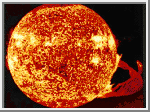Is the Sun on fire?

Where does the energy production of the Sun come from?
Maybe it is burning.
Any intelligent child might ask this question. A child doesn't have
the knowledge base to answer it, but now we do.
- Consider an example of burning methane (natural gas):
C H4 + 2 O2 --> C O2 + 2 H2 O
- Laboratory measurements show that burning methane releases
an amount of energy per kg of ingredients equal to
E/M = 1.1 x 107 J/kg
(Recall that a watt is a joule (J) per second).
- The mass of the Sun is
M = 2 x 1030 kg
- So if the whole Sun were made of methane and oxygen, the energy that
could be released by burning all of it would be
E = (E/M) x M = (1.1 x 107 J/kg)
x (2 x 1030 kg)
= 2.2 x 1037J
- That's a lot. But the Sun is radiating energy at a rate of
L= 4 x 1026 J/s
- Burning methane at that rate, it would last for a time
t = E/L = 2.2 x 1037J
/ (4 x 1026 J/s)
~ 6 x 1010s
- There are 3 x 107 seconds in a year, so this time is
t
~ (6 x 1010s) /( 3 x 107 s/yr)
~ 2000 years
- Since the Earth has been around, and reasonably warm, much longer than that, we may conclude that the source of the Sun's energy is not burning
methane.
- And it can't be any other chemical process either, since the energy
available in any chemical process is roughly the same as for burning
methane.
ASTR 122 course home page
Updated 3 October 2007
Davison E. Soper, Institute of Theoretical Science,
University of Oregon, Eugene OR 97403 USA
